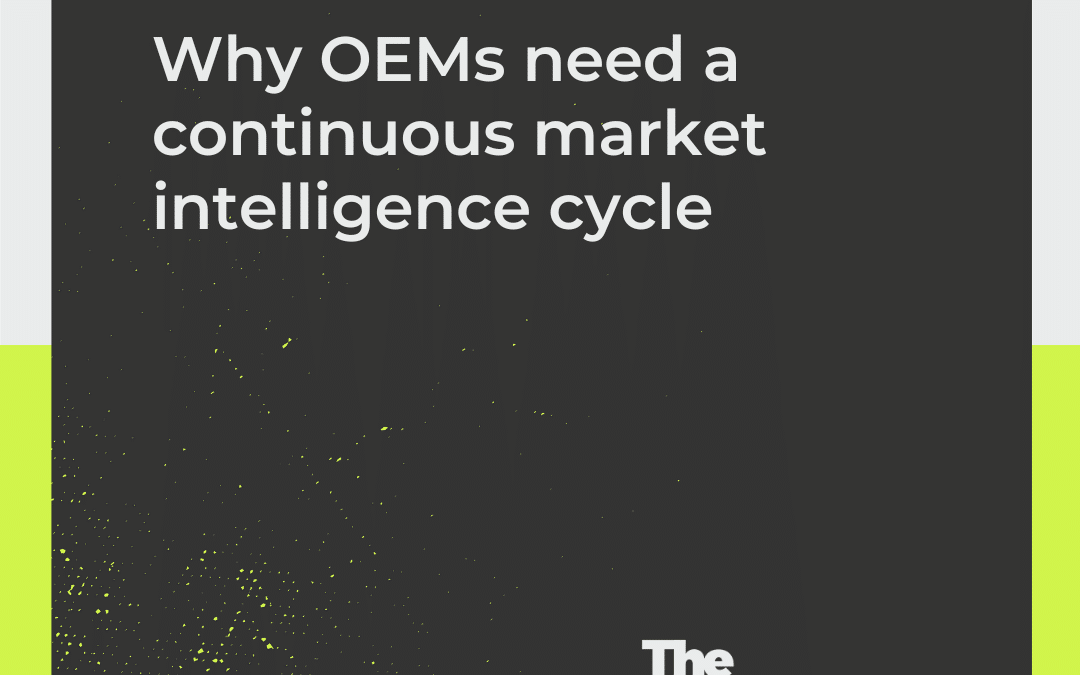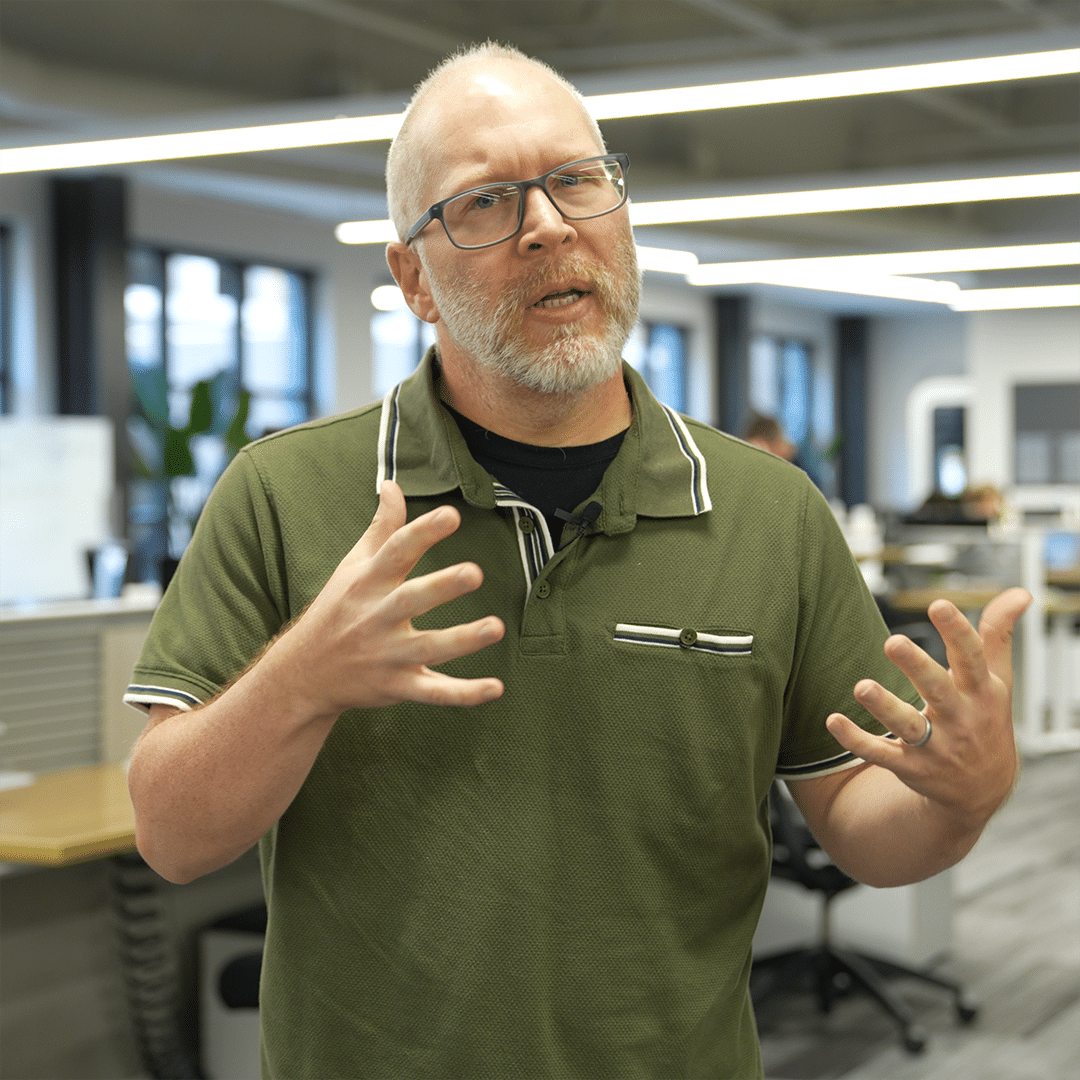Why OEMs Need a Continuous Market Intelligence Cycle
The Inventory
This Episode
Launching a new product in a crowded market? For OEMs and dealers, success hinges on more than just the product itself.
In this episode, Joe Mills speaks with Brian Cole, Director of Marketing Strategy at Element Three, about how marketing can become the backbone of product sales and distribution. They discuss setting up dealers for success, crafting brand stories that resonate, and the strategies that drive results.
You’ll learn:
- How marketing can become a vital partner in product sales and distribution
- Why aligning with product and sales teams creates stronger product launches
- Practical ways to equip dealers with tools for successful customer engagement
Episode Transcript
This transcript was generated with the help of AI and may contain some errors.
Brian Cole [00:00:00]:
Let’s say you’re moving into a whole new, like, market with this new vertical of vehicles or whatever that is. It could be that that has enough of a shift on your portfolio that you need to slightly craft your story about your whole company to make that make sense. And so it might be that you’re not just doing this launch campaign for this product, that you are also refreshing your brand campaigns, updating your website more broadly than just a new product page. So there’s a whole suite of things that have to happen there to make the story make sense for the whole company and the audience that’s going to buy it.
Show ID [00:00:37]:
Welcome to The Inventory, the show designed to give OEMs and dealers like you actionable insight on channel marketing. From co op programs to product portfolio design. We’ll arm you with the information you need to excel, to enter new markets successfully, to build lasting OEM dealer relationships, and ultimately to move more inventory. Let’s get started.
Joe Mills [00:00:56]:
Hey everyone. On today’s episode, we are joined by Brian Cole.
Joe Mills [00:01:01]:
Brian is the director of marketing strategy.
Joe Mills [00:01:02]:
Here at Element Three, and we are going to talk about how marketing can be an enabler for both product sales and distribution all throughout the cycle of your business as you bring new products into market. We’ll also talk about a couple tactical things you can do right now, depending on where you’re at in that timeframe. Hope you enjoy. Brian, thanks so much for coming on the show, man. Excited to talk to you at a high level. Can you start with setting the table for what we’re talking about today in regards to product launch?
Brian Cole [00:01:30]:
Yeah, totally. I think the best way to say it is that if I’m speaking to heads of marketing who are fighting for relevance and trying to get the most out of the seat at the table, they have the leadership of their companies when it comes to launching products. What I would say is you are an enabler to those other go to market partners in the business that have really important critical roles. The product team who’s developing new products and then the sales and your distribution network who are getting those in front of customers. So in addition to the sort of always on marketing things that you’re doing, putting new products in the world involves front end and back end things that you should be doing to make their jobs easier.
Joe Mills [00:02:12]:
Cool. Let’s just go into both of those. Front-end, back-end.
Joe Mills [00:02:14]:
Which side do you want to start on?
Brian Cole [00:02:16]:
Let’s start with the front end.
Joe Mills [00:02:16]:
Okay.
Brian Cole [00:02:17]:
When I think about a marketing team helping a product team launch a product, it is mostly front end. Intelligence. So this is sort of a somewhat obvious but maybe not commonly remembered thing. But I think that every product for these manufacturers should be something that closes a gap or opens a door in the portfolio so that you can reach the customers you want to reach or avoid the competition you want to avoid. So what marketing should be doing is helping that product team know. What does the market think about your products now? What do your customers think about your products now? What is your competition doing? How are your current products performing? Are there sales dips? Are there things going up, down your metrics on your interaction with people, talking to customers, getting feedback? All of that information should be fed to that product team so they can make faster, better decisions about how to close gaps or open doors in their portfolio.
Joe Mills [00:03:14]:
A couple things went through my head. I think to make the close gaps or open doors part, a really easy way to think about this is to consider if you’re entering like a different class.
Brian Cole [00:03:23]:
Yeah.
Joe Mills [00:03:23]:
So if in the RV space you’re moving from maybe a towable to a motorized or if you’re a commercial vehicle manufacturer, maybe you’ve always made Class 4 trucks and you are going to try to get into long haul and you’re going to go Class 7, 8 totally to open up a new market for you. On the flip side, maybe you’re a dominant player in the space and you’re seeing disruption happen in adjacent markets and you’re saying I want to shut that door before I get disrupted. There’s a thing that went through my head and then I think the other piece here is what you’re really describing is being like a product research arm and in today’s day and age being able to use connected devices and all sorts of information that you can gather from telematics and tons of things that you can do. Marketing actually I feel like what you’re saying, tell me if this is wrong, has a responsibility to take all of that information they’re getting from the marketplace, be that from things like connected devices, but also through interaction on current advertisements and what’s selling well. And like distill that down to make it actionable for their product team to then go develop things for.
Brian Cole [00:04:21]:
Yeah, 100%. And I think, you know, we’re talking to the words we’re using are about we’re launching a new product in the market. But something to remember is that that is just one part of managing a portfolio over time. And that product team is thinking about what products do we sell? How does that tie to our strategy, our business goals, the customers we’re trying to reach the market, we’re trying to own. Sometimes product launch might be you are sunsetting one product and replacing it with a different one. Well, sometimes it might be you’re adding a net new product. And so it’s not only what does everyone need to know about this product, but how does that fit with the rest of the products? Like what, what is the thing that you maybe are replacing on a different product? Sometimes it’s just a generational update of a product. It’s a renaming of a product.
Brian Cole [00:05:07]:
Could be, like you said, you’re going into a whole different, like market space. All of those are going to be sort of different volumes of product launch. But they all require that intelligence to know that you’re going to release a thing that hits the audience it needs to.
Brian Cole [00:05:22]:
Yeah.
Joe Mills [00:05:23]:
It also reminds me of one of our clients. They’ve built their business on continually updating their product versus in their industry. It’s much more common to have model year turns.
Brian Cole [00:05:32]:
Totally.
Joe Mills [00:05:32]:
And the way that marketing has to.
Joe Mills [00:05:34]:
Perform to enable that business is totally different than somebody who’s got every April 1st we release the next product year.
Brian Cole [00:05:41]:
Yeah.
Brian Cole [00:05:41]:
And I think that there’s a little bit of a risk in thinking of research intelligence for product launch being a thing you do. You know, when the product team says they’re going to launch a new product, it should not be a reactionary activity. That should be sort of an always on engine that you’re running to keep them informed about things that you’re seeing so that you can help them make those decisions about when to do it. Not just, you know, whether they’re doing the right thing. And they’ve already decided.
Joe Mills [00:06:08]:
Last one. And then I want to jump into the sales side of this and talk through that. But you and I were lucky enough to go up to a major furniture manufacturer and tour their space. And it was very interesting seeing the way that they do product development.
Brian Cole [00:06:21]:
Yeah.
Joe Mills [00:06:22]:
They like set a whole theme and like what is the idea behind where all of our products are moving? And then they start to break that down by product line. And for them as a furniture manufacturer, they have a very broad set of SKUs.
Joe Mills [00:06:37]:
Really?
Brian Cole [00:06:37]:
Yeah.
Brian Cole [00:06:37]:
And they had a clear story about every product that they could tell. And that story was not something that, you know, they made the chair and decided what this is about. That story goes all the way back to what need is there, what inspiration did we take from this to make the thing? And now how is it going to help people do a thing that they need to do a little Bit better.
Joe Mills [00:06:59]:
Right. Which I think leads us into the sales side because it’s like, okay, great. When they have to go enable that story in the marketplace and salespeople have to go move product through their distribution network. Be that dealers in this case, price down dealers.
Brian Cole [00:07:11]:
Yep.
Joe Mills [00:07:12]:
What needs to happen in that side of the world?
Brian Cole [00:07:14]:
Yeah.
Brian Cole [00:07:14]:
There’s sort of, I would say the no duh moment here is that no one’s going to buy a product that they don’t know about and they can’t see themselves in. And so marketing’s role here, and we’re kind of moving now from that before the product development thing really gets off the ground to now we’re getting ready to push out this new RV, this new boat to the audience. What marketing’s role there is really from our perspective is velocity of sales after launch. So how can you prepare the dealers through training, education, resources, so that once those things hit the lot or even before they hit the lot, they’re already turning sales or turning conversations. What can you do with sales to make them enabled to start having conversations even before the thing is out about what’s coming, why you’re launching it and telling that story about the product. The other thing is then you get into like the marketing co marketing programs with dealers and your distribution network, ensuring that you are getting the right change to your brand messaging if necessary. You mentioned earlier, let’s say you’re moving into a whole new, like, market with this new vertical of vehicles or whatever that is. It could be that that has enough of a shift on your portfolio that you need to slightly craft your story about your whole company to make that make sense.
Brian Cole [00:08:34]:
And so it might be that you’re not just doing this launch campaign for this product, that you are also refreshing your brand campaigns, updating your website more broadly than just a new product page. So there’s a whole suite of things that have to happen there to make the story make sense for the whole company and the audience that’s going to buy it.
Joe Mills [00:08:52]:
There’s actually a piece you said way at the beginning where you said this is kind of obvious. People are not going to buy a product they don’t know about. Agreed. Easy. Understandable. The second jump you made is and can see themselves in.
Brian Cole [00:09:04]:
Yeah.
Joe Mills [00:09:04]:
And I actually think that gets missed a lot.
Brian Cole [00:09:06]:
Totally.
Joe Mills [00:09:07]:
It’s like I gotta tell people about my product. But in the way that you do that, you can either fail to tell a compelling story that helps them understand like why should I care about that product?
Brian Cole [00:09:16]:
Yep.
Joe Mills [00:09:16]:
Why should I individually use that product.
Joe Mills [00:09:19]:
What challenge is it solving for me that my current one doesn’t?
Brian Cole [00:09:21]:
Yep.
Joe Mills [00:09:22]:
You know, if you think about, we’ve mentioned boats and RVs and things of that nature, you want to look at repeat purchase as a major component of your. Your product strength and overall, like performance as a company. And so if I’m, you know, I’m going around in my. My sport. Sport boat already and I’m wake surfing and I’m happy with it and everything’s great and you drop a $250,000 boat onto the market, you need to show me as a buyer.
Brian Cole [00:09:46]:
Yep.
Joe Mills [00:09:47]:
Why am I going to go buy the equivalency of a starter home?
Brian Cole [00:09:50]:
Yep.
Joe Mills [00:09:51]:
To replace the thing that I’m already using.
Brian Cole [00:09:52]:
Yep.
Brian Cole [00:09:53]:
We talk a lot in the — When we work with our clients on this. Comes up a lot in brand work and website updates and messaging, but we talk a lot about this shift from, you know, don’t talk about what you do, talk about what they get. And that speaks to what you’re saying is don’t just tell everybody you have a new product. Tell the specific people that that product was designed to serve based on the intelligence that you fed to the product team that there is a thing that is great for them and give them ways and reasons to imagine. Or even through, I would say, test drives or industry shows.
Joe Mills [00:10:31]:
Boat shows. Yeah.
Brian Cole [00:10:32]:
Like be able to go and actually imagine it physically. Like what they could be doing with that product.
Joe Mills [00:10:39]:
Yeah. I think to wrap the thing I’m hearing from you is marketing sits at the central point. And when it’s doing, when it’s enabling product and sales really well, what it’s actually able to do is help to define what’s the need we’re trying to solve with this product.
Brian Cole [00:10:53]:
Exactly.
Joe Mills [00:10:53]:
And then pull that story all the way through so that when it finally goes through development cycles and is ready to be launched and the sales team has to go make things happen inside of the dealer network and the dealers have to ultimately move product for you.
Joe Mills [00:11:05]:
You can tell a very clear, compelling.
Joe Mills [00:11:08]:
Concise story that fits with your brand. Doesn’t need to be that like, oh, that’s a stretch moment. But it’s rather like, oh, that’s seamless. It makes a bunch of sense. And now you’re moving product.
Brian Cole [00:11:16]:
Yeah.
Brian Cole [00:11:17]:
And what, you know, we won’t spend a lot of time on it now, but then you’re starting the cycle again at that point. Now you get back into the intelligence and say, what did dropping this new product in the market do to what the perception is of the whole portfolio, Does a new gap open? What does the competition do to react to this product? Did they launch something that’s just like it? Now what do we do? So that you’re just sort of always spinning that product wheel in the same way you spin a marketing wheel. And those two things can be working together really well to keep each other informed and educated.
Joe Mills [00:11:47]:
Cool. So, Brian, as we get close to wrapping here, you, I know, came prepared with a couple of tactical things people can go do immediately. You want to go over those?
Brian Cole [00:11:55]:
Yeah.
Brian Cole [00:11:55]:
So for, for companies who are out there and marketing leaders out there who are in the middle of preparing for a launch, if nothing else, go make sure your dealers have everything they need. I would focus on your highest performing dealers, those like, top dealers. Everyone has their, like main dealers, the.
Joe Mills [00:12:13]:
20% who are doing 80% of the value.
Brian Cole [00:12:15]:
Find out from them if they have everything they need that would make them feel very successful in getting a new product on their lots. And if they have things that they want more of or need differently, go do those things as fast as you can and then get it to every other dealer. If you’re not in that moment, you’re just sort of on the bottom side of that research cycle. I would go and start to build a framework for product intelligence and market intelligence that you can be feeding back to that team on the product side all the time.
Joe Mills [00:12:46]:
Is that something that you do with the product team? Mostly people don’t have somebody with the title of like product marketing. Tech firms do, for example, but yes, these. These firms do not. Is that a. A joint venture of sorts between product and marketing?
Brian Cole [00:12:59]:
Yeah.
Brian Cole [00:12:59]:
I would imagine that there are product leaders in these organizations, most of them, who are already thinking about these things and could use a partner to go and source those things and find the right things from them.
Joe Mills [00:13:11]:
Great. So go to your product leader.
Brian Cole [00:13:12]:
Yep.
Joe Mills [00:13:13]:
Ask them about this and start building that framework.
Brian Cole [00:13:14]:
Yep.
Brian Cole [00:13:15]:
Go be a team.
Joe Mills [00:13:15]:
Awesome.
Joe Mills [00:13:16]:
Element Three is a full service marketing agency that bridges the gap between OEMs and their dealers. For more insights on how to go to market well in the dealer model.
Joe Mills [00:13:26]:
Head to elementthree.com.
Sharing Expertise
What good is learning something if you don't pass it on? You can tap into what we know right now – from dealer programs to determining brand architecture – and you don't have to give us a thing.




